R.J. Stowell's Blog: rjsomeone, page 12
January 20, 2021
Calif.- Get Your Signed Copy Now!
Calif. is the latest novel by AM's R.J. Stowell, author of Miles From Nowhere and Jay and the Americans. Get your copy now at Amazon (click HERE). You can also read each of the novels FREE on Kindle Unlimited, which currently has a free two-month trial.
From the Book Jacket: In Miles From Nowhere, our hero takes a 3000-mile trek across 60's America to see his idol, Jimi Hendrix, at Woodstock. His poor health and America do nothing but get in the way. In Calif., Miles is back, alive and kicking, but it wasn't easy. Here is the rest of Miles' story.
Calif. is the standalone sequel to 2019's Miles From Nowhere, a cross-country trek of a young man's pilgrimage to Woodstock. In 1970, Miles is back in California making a go of it, working at a rock club on the coast. While his health is touch and go, the ramifications of a kidney transplant, like all of us, Miles struggles with life, death, love, giants, rock stars, tigers, a wife, a daughter and the double yellow line. Calif. is what happens when the coming of age tale has ended, when the California realities set in and the fantasy that was Woodstock is only a memory.
Want an autographed copy? Send an email to rjsomeone@gmail.com and I'll send an invoice through Paypal. Just $12 including shipping.
January 18, 2021
The Origins of Progressive Rock – Details
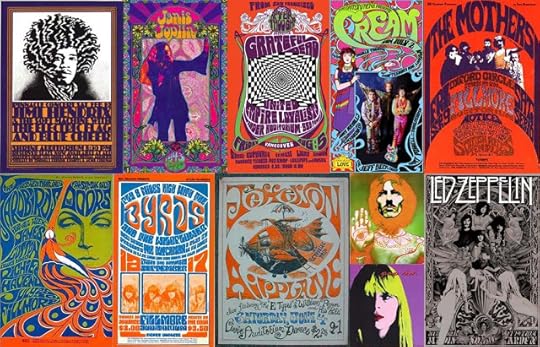
Rock music experienced a seismic change between 1966 (Rubber Soul) and 1969, inspired by art, poetry, jazz, India, classical music – and drugs. Psychedelia permeated the three guitars and a drum sensibility the Beatles created in the early 60s. Rock 'n' Roll became "Rock," for this writer, with a single riff in 1965. There isn't a soul who doesn't recognize it – Keith Richards' iconic hook on "Satisfaction." Rock's venture into the progressive subgenre arguably came about in July 1965 with Dylan's "Like A Rolling Stone," a six-minute single (twice the length of the average 45) with lyrics that promised profound truth and the wisdom of youth.
Inspired by Rubber Soul, The Beach Boys' Pet Sounds, with its Theremins, bicycle bells and barking dogs, arrived in May 1966. Three months later, The Beatles responded with the multi-layered Revolver with Harrison's sitar and Lennon's backward tape loops. In December came The Who's A Quick One, "a mini rock opera" leading up to Tommy in 1969.
Despite its imminent demise a few years later, AM pop radio was equally infected with The Yardbirds' "Shapes of Things," Pink Floyd's "See Emily Play," and The Left Banke's "Walk Away Renee." And don’t get me started on Jimmy Webb's game-changing hit from Richard Harris, "McArthur Park."
New records were borrowing from jazz, spacy country, musique concrète, old-English vaudeville and Burt Bacharach. Rock 'n' Roll was about sex, and suddenly, the forebearers of progressive rock were making us think. But why? One word and a few letters: Maryjane and LSD. Cannabis had greased music's wheels since the jazz era, but the impact of LSD turned pop music inside out. Even groups who never touched the stuff started making music that sounded like they did.
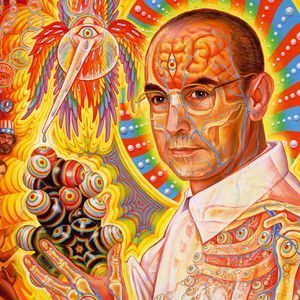 "I put my hand up, I tried LSD," said Moody Blues guitarist Justin Hayward looking back. Hayward joined the band in 1966 and helped engender their move away from R&B to art-rock. "We sat there holding hands. I found the culture around LSD profoundly interesting."
"I put my hand up, I tried LSD," said Moody Blues guitarist Justin Hayward looking back. Hayward joined the band in 1966 and helped engender their move away from R&B to art-rock. "We sat there holding hands. I found the culture around LSD profoundly interesting." For Hayward, the year was all about, "Head magazines like International Times, Aldous Huxley's The Doors Of Perception and Timothy Leary." The Moodies, of course, would record the Leary inspired "Legend Of A Mind," on their 1968 LP In Search of the Lost Chord.
Before it from The Beatles' Sgt. Pepper sessions was "Strawberry Fields," which fellow acidhead Pete Townshend called "creative, strange and different." Townshend had become a regular at UFO, a London club where everyone – band and audience – was tripping. Once the lads released Sgt Pepper, "the whole world changed," according to Hayward (and everyone else). It was pop music reimagined through the prism of LSD, Abbey Road's state-of-the-art studios and The Beatles' boundless imagination. "Pop music could now be whatever it wanted to be."
Kevin Godley (Godley Crème, 10cc) said of Pepper, "It was so strange it was almost alien. On the day it came out, everyone in college stopped working and was listening… Everything changed. It was like the first iPhone. Okay, it was just a phone before, but now it’s this."
As instrumental as Britain was psychedelically, the genre found its roots equally in the States. Garage rock was the American equivalent to the spacey U.K. bent, but with far more diversity, The Velvet Underground at one end of the country, Zappa in L.A., the Grateful Dead and Jefferson Airplane in the trippy Bay area with "White Rabbit" its poster child.
Justin Harward said, "We listened to everything coming out of America: The Byrds, The Beach Boys, anything on Elektra Records, The Doors, Love," Hayward singles out Buffalo Springfield "as a major influence on the London scene," but there was a difference from one side of the Atlantic to the other: America was immersed in a bloody and unpopular war. American psychedelia didn't lead to the gentle whimsy of 70s prog. Instead, it grew horns and turned into Captain Beefheart's Trout Mask Replica or the heavy stoner rock of Blue Cheer and Iron Butterfly, while the U.K. went classical and ethereal.
Case in point, Procol Harum. Their iconic No.1 single, "A Whiter Shade Of Pale," was inspired by Johann Sebastian Bach and included fantasy lyrics about vestal virgins. "It's like the construction of a jigsaw puzzle without knowing what the finished picture will be," explained lyricist Keith Reid. "I start off with one or two pieces or fragments of a concept, then, by interlocking pieces, I build up a picture that makes sense and conveys my thoughts and meaning." He could have been Jon Anderson talking about Yes.
Paul McCartney had his first listen to the track at London's Speakeasy club and said, "This is the best song I ever heard, man." From there the trippy, psychedelic experience included Cream, the Incredible String Band and then, an LP to rival Pepper, The Small Faces' Ogden's Nut Gone Flake. From there, it wasn't a very big step to usher in Tommy and Traffic and despite itself, Floyd's Ummagumma made it all the way to No. 3. I can still chant the obscure lyrics to "Several Species Of Small Furry Animals Gathered Together In A Cave And Grooving With A Pict," with its hidden message, "That was pretty avant-garde, wasn’t it?"
All of this, of course, led to Crimson's In the Hall of the Crimson King, a stellar culmination of jazz, rock, psychedelia, beautiful lyrics, gorgeous vocals, horrific concepts, and unrivaled musicianship. Like a phoenix, rock had burned itself up and reappeared with a new vitality that by 1971 would fly up like Icarus to heights it never before dreamed.
While AM doesn't condone or romanticize the use of illicit substances, there is no denying their impact on psychedelia and the music of the 60s and 70s.
The Arbiters of Prog
My pet peeve for rock radio is its greatest hits approach. (Did Yes even have another song than "Roundabout?" You’d wonder.) With that, AM strives NOT to do the same. It's interesting that rock music arguably begins with Robert Johnson in the 1930s and that Keith Richards or Lennon or Page look back at Elvis and Chuck Berry or Howlin' Wolf as their inspiration, yet most of us dismiss such introspection.
All of us know the classic AM staple "Louie, Louie" by the Kingsmen, which featured Don Gallucci on vocals and keys. Gallucci would go on to form Touch with a lineup including Jeff Hawks (vocals), Bruce Hauser (vocals, bass), Joey Newman (vocals, guitars), and John Bordonaro (vocals, percussion). The band rented a Hollywood castle to rehearse and host lavish shindigs with record executives and producers at which they’d perform, Gallucci was no intern. Coliseum/London Records won the contract bid with an unheard of $25,000 advance and the band began recording (let's call it partying) at Sunset Sound. Nonetheless, word got out of what the band put to tape and soon the castle was a hangout for artists like Grace Slick, Mick Jagger, and even Hendrix. The debut LP, Touch, exemplifies the spirit of the 60s, a record overflowing with experimentation and musicianship. "Seventy-Five" is one of the great early progressive rockers with a gem of a guitar solo and a heavy [metal], atmospheric vocal performance from Jeff Hawks. "Down At Circe's Place" is a psychedelic classic with otherworldly vocals, spaced-out guitar and keyboard noodling, powerful drum work and trippy sound effects – everything you didn't know you wanted at the time. Gallucci would go on to produce the Stooges' Funhouse, impressive in itself, but Touch remains his finest hour in rock, progressive rock at that.
January 15, 2021
Heroes & Villains - Progressive Rock? Oh, Yeah.
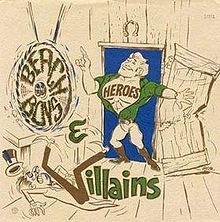 Progressive rock in its most informative years was an exclusively British club (one need only discount the progressive-light banality of Styx and Kansas). It's odd then that the LP that AM commends as a catalyst for progressive music, The Mothers' Freak Out, is an American construct, as is AM's choice for catalytic song, The Beach Boys' "Heroes and Villains." Ask any stranger on the street to name 10 Beach Boys songs, and "Heroes and Villains" won’t make the list.
Progressive rock in its most informative years was an exclusively British club (one need only discount the progressive-light banality of Styx and Kansas). It's odd then that the LP that AM commends as a catalyst for progressive music, The Mothers' Freak Out, is an American construct, as is AM's choice for catalytic song, The Beach Boys' "Heroes and Villains." Ask any stranger on the street to name 10 Beach Boys songs, and "Heroes and Villains" won’t make the list. The track, in all its incarnations (ultimately deconstructed when released as a 45), "H&V" meets every prog criteria: epic in scope; time changes and odd time signatures; complex, sophisticated instrumentation and composition; conceptual ideas and heightened, lyrical content; classical and jazz influences; indeed "H&V" goes out of its was to meet the guidelines. One is hard-pressed to identify the track as a Beach Boys' song. Where the equally complex "Good Vibrations" is so obviously a BB tune, "H&V" is so painstakingly obtuse that the fact that it made it nearly into Billboard's Top Ten is quite a statement about 1967's diversity.
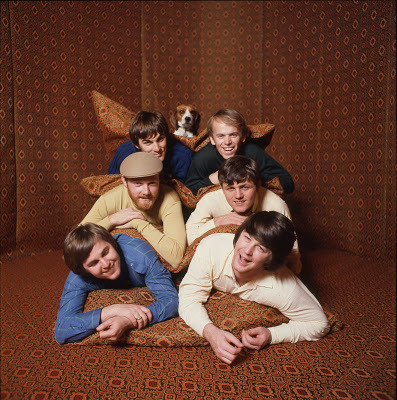 Numerous segments, specifically written in modular fashion, are strewn together to create a pop-music pastiche that's significantly more adventurous than "Good Vibrations." Whereas ideas were tinkered with for roughly six months to piece together "Good Vibrations," "Heroes and Villains" took a year. "Good Vibrations" reached mass critical and commercial success primarily because it is brilliant in theory and execution, but it also benefits from the fact that it's lyrically relate-able. "Heroes and Villains," for all its stunning vocal harmonies, lacks such a linear lyrical plot. It makes no sense on any level.
Numerous segments, specifically written in modular fashion, are strewn together to create a pop-music pastiche that's significantly more adventurous than "Good Vibrations." Whereas ideas were tinkered with for roughly six months to piece together "Good Vibrations," "Heroes and Villains" took a year. "Good Vibrations" reached mass critical and commercial success primarily because it is brilliant in theory and execution, but it also benefits from the fact that it's lyrically relate-able. "Heroes and Villains," for all its stunning vocal harmonies, lacks such a linear lyrical plot. It makes no sense on any level.When SMiLE was shelved in May 1967, so was "Heroes and Villains," but several tracks from the SMiLE sessions would reappear in later years in severely toned down form. In the case of "H&V," what is left is the odd mix of melody and the diversity of the lyrics (corny as Van Dyke Parks lyrics tended to be, they fit like a puzzle and were transformed with Brian Wilson's musical compositions. Think of "Surf's Up," one of AM’s choices for the most beautiful song ever, strip away the gorgeous textures and melody, the voicing and the phrasing, and the lyrics are just plain silly).
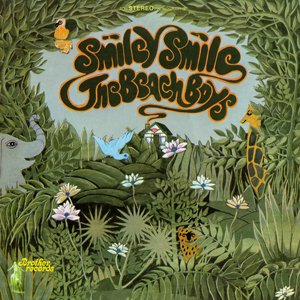 Parks would prove to be one of the most extreme surrealistic lyric writers, taking his cue from his love of James Joyce's word play. Low on personal expression, the lyrics tumble along the chromatic shifts in the song and fall into felicitous rhyme. "Heroes and Villains" starts abruptly with the lyric without any musical introduction, with most of the attention on developing the vocal tracks. The instrumental accompaniment is limited to the organ, a harpsichord, and an occasional whistle - with a standard rock band accompaniment mixed very lowly in the background. The verses take a simple falling major scale, and convert it into a harmonic masterpiece, and the chorus starts from an almost mindless, repetitive two-chord keyboard exercise into high order counterpoint. Only then comes the best bit: "My children were raised" provides a new harmony for the falling scale, alters the tempo, and provides the final push to prog perfection.
Parks would prove to be one of the most extreme surrealistic lyric writers, taking his cue from his love of James Joyce's word play. Low on personal expression, the lyrics tumble along the chromatic shifts in the song and fall into felicitous rhyme. "Heroes and Villains" starts abruptly with the lyric without any musical introduction, with most of the attention on developing the vocal tracks. The instrumental accompaniment is limited to the organ, a harpsichord, and an occasional whistle - with a standard rock band accompaniment mixed very lowly in the background. The verses take a simple falling major scale, and convert it into a harmonic masterpiece, and the chorus starts from an almost mindless, repetitive two-chord keyboard exercise into high order counterpoint. Only then comes the best bit: "My children were raised" provides a new harmony for the falling scale, alters the tempo, and provides the final push to prog perfection. In another era, "Heroes and Villains" may have revolutionized the 45 in the same way SMiLE may have revolutionized the L.P. Instead, "Heroes and Villains" is a testament to a road not taken, the American road to progressive music.
Heroes & Villains - Hits of '67 - Beach Boys Part 2
 Progressive rock in its most informative years was an exclusively British club (one need only discount the progressive-light banality of Styx and Kansas). It's odd then that the LP that AM commends as a catalyst for progressive music, The Mothers' Freak Out, is an American construct, as is AM's choice for catalytic song, The Beach Boys' "Heroes and Villains." Ask any stranger on the street to name 10 Beach Boys songs, and "Heroes and Villains" won’t make the list.
Progressive rock in its most informative years was an exclusively British club (one need only discount the progressive-light banality of Styx and Kansas). It's odd then that the LP that AM commends as a catalyst for progressive music, The Mothers' Freak Out, is an American construct, as is AM's choice for catalytic song, The Beach Boys' "Heroes and Villains." Ask any stranger on the street to name 10 Beach Boys songs, and "Heroes and Villains" won’t make the list. The track, in all its incarnations (ultimately deconstructed when released as a 45), "H&V" meets every prog criteria: epic in scope; time changes and odd time signatures; complex, sophisticated instrumentation and composition; conceptual ideas and heightened, lyrical content; classical and jazz influences; indeed "H&V" goes out of its was to meet the guidelines. One is hard-pressed to identify the track as a Beach Boys' song. Where the equally complex "Good Vibrations" is so obviously a BB tune, "H&V" is so painstakingly obtuse that the fact that it made it nearly into Billboard's Top Ten is quite a statement about 1967's diversity.
 Numerous segments, specifically written in modular fashion, are strewn together to create a pop-music pastiche that's significantly more adventurous than "Good Vibrations." Whereas ideas were tinkered with for roughly six months to piece together "Good Vibrations," "Heroes and Villains" took a year. "Good Vibrations" reached mass critical and commercial success primarily because it is brilliant in theory and execution, but it also benefits from the fact that it's lyrically relate-able. "Heroes and Villains," for all its stunning vocal harmonies, lacks such a linear lyrical plot. It makes no sense on any level.
Numerous segments, specifically written in modular fashion, are strewn together to create a pop-music pastiche that's significantly more adventurous than "Good Vibrations." Whereas ideas were tinkered with for roughly six months to piece together "Good Vibrations," "Heroes and Villains" took a year. "Good Vibrations" reached mass critical and commercial success primarily because it is brilliant in theory and execution, but it also benefits from the fact that it's lyrically relate-able. "Heroes and Villains," for all its stunning vocal harmonies, lacks such a linear lyrical plot. It makes no sense on any level.When SMiLE was shelved in May 1967, so was "Heroes and Villains," but several tracks from the SMiLE sessions would reappear in later years in severely toned down form. In the case of "H&V," what is left is the odd mix of melody and the diversity of the lyrics (corny as Van Dyke Parks lyrics tended to be, they fit like a puzzle and were transformed with Brian Wilson's musical compositions. Think of "Surf's Up," one of AM’s choices for the most beautiful song ever, strip away the gorgeous textures and melody, the voicing and the phrasing, and the lyrics are just plain silly).
 Parks would prove to be one of the most extreme surrealistic lyric writers, taking his cue from his love of James Joyce's word play. Low on personal expression, the lyrics tumble along the chromatic shifts in the song and fall into felicitous rhyme. "Heroes and Villains" starts abruptly with the lyric without any musical introduction, with most of the attention on developing the vocal tracks. The instrumental accompaniment is limited to the organ, a harpsichord, and an occasional whistle - with a standard rock band accompaniment mixed very lowly in the background. The verses take a simple falling major scale, and convert it into a harmonic masterpiece, and the chorus starts from an almost mindless, repetitive two-chord keyboard exercise into high order counterpoint. Only then comes the best bit: "My children were raised" provides a new harmony for the falling scale, alters the tempo, and provides the final push to prog perfection.
Parks would prove to be one of the most extreme surrealistic lyric writers, taking his cue from his love of James Joyce's word play. Low on personal expression, the lyrics tumble along the chromatic shifts in the song and fall into felicitous rhyme. "Heroes and Villains" starts abruptly with the lyric without any musical introduction, with most of the attention on developing the vocal tracks. The instrumental accompaniment is limited to the organ, a harpsichord, and an occasional whistle - with a standard rock band accompaniment mixed very lowly in the background. The verses take a simple falling major scale, and convert it into a harmonic masterpiece, and the chorus starts from an almost mindless, repetitive two-chord keyboard exercise into high order counterpoint. Only then comes the best bit: "My children were raised" provides a new harmony for the falling scale, alters the tempo, and provides the final push to prog perfection. In another era, "Heroes and Villains" may have revolutionized the 45 in the same way SMiLE may have revolutionized the L.P. Instead, "Heroes and Villains" is a testament to a road not taken, the American road to progressive music.
January 11, 2021
The Origins of Prog... Revisted
I maintain that progressive rock's catalyst into popularity was Gentle Giant's and Emerson, Lake and Palmer's eponymous debuts in late 1970. Stating that has caused a myriad of arguments, most that point to King Crimson instead. I buy that, though, from a practical standpoint, my argument remains – neither King Crimson nor the Canterbury Scene or even the Moody Blues fully established prog in its commercial sense. Brian Eno's remark about the Velvet Underground remains true: only 30,000 people bought the Velvets' debut, "but everyone who bought one started a band."
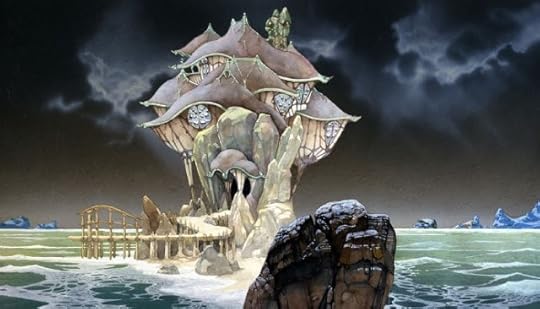
Nonetheless, acknowledging that there was a plethora of Velvets, leads me to these, ahem, five – the catalysts of the catalysts (this ought to rip the top off a can of worms):
1. The Mothers of Invention – Freak Out! (June 1966). Alice Cooper said, "Before prog and shock rock, you had Frank and his musicians who were doing something unlike any other band I'd heard before." Freak Out! was as psychedelic as the day was long and in this, those who insist on pigeonholes neglect its prog influence in the same way they do #2 on the list. A brash opening statement from Zappa that he would make the music he wanted and didn't care who he failed to please or to offend along the way. From the Mr. America in "Hungry Freaks, Daddy" who brushes under the carpet the unseemly aspects of suburban life to the avant-garde parody of American self-assurance "It Can't Happen Here," the almost angry attack on the mainstream West is unflinching. Devoted to avant pioneer Edgard Varèse, R&B, and experimentation with tape loops, Zappa had the Mothers "master-planned" years before he hijacked L.A. bar band The Soul Giants into his surreal vision. Not prog, you insist, see No. 2.
2. The Beatles – Sgt. Pepper's Lonely Hearts Club Band (May 1967). The psychedelic poster child doesn't have Zappa's quirky time signatures or avant-garde [lack of] focus, but its concept, dreaminess, and surrealism are a constant of things to come. If not a progressive LP itself, Sgt. Pepper is the most non-progressive LP to influence the likes of Genesis, Tull, Can or more modern bands like Porcupine Tree.
3. Pink Floyd – The Piper at the Gates of Dawn (August 1967). Named after a chapter in Kenneth Grahame's The Wind In The Willows, Pink Floyd's whirling amalgam of psychedelia and space rock was highlighted by Syd Barret's astoundingly proggy songwriting. From the whimsy of "Bike" and "The Gnome" (which harken back to Bowie's debut a month earlier) to proto-prog epics like "Astronomy Domine" and "Interstellar Overdrive," the album is a colorful mix of the sounds of its time – and another peek into the future. I don't usually catalog Floyd alongside progressive artists like Gentle Giant or Yes, but the influence is unmistakable.
4. Moody Blues – Days of Future Passed (November 1967). "We were originally a rhythm-and-blues band," Justin Hayward said, "but it was incongruous, getting us nowhere, and in the end, we had no money, no nothing." Then came what Hayward called "a series of wonderful accidents." Decca ventured into its new stereo format with Deram Records and to foot the bill for the new studio asked that The Moodies to record a rock version of Dvorak's New World Symphony. Michael Barclay, the project's coordinator, suggested turning it around – The Moodies' songs interspersed with orchestration; symphonic rock was born. Later offerings from the band would be far more progressive, but without Days, that would never have come to fruition.
5. In the Court of the Crimson King would be released in October of 1969 and, as one of my all time favorites (and yes, you’ve heard me say I like Poseidon more), I’m not likely to refute its stature, but I’ve paid tribute enough. Yet if I X it out of the list, I struggle with my choices leading up to GG and ELP. Choose your own ending to the post, therefore with bands and debuts from Magma, Fairport Convention, Curved Air, Van der Graf Generator, Caravan – hell, I see the prog in The Beach Boys’ “Heroes and Villains;” and leave it up to you.
January 9, 2021
Carl Palmer's Turn
 Formed in 1969 by keyboardist Vincent Crane and drummer Carl Palmer, Atomic Rooster was one of the pioneering groups in progressive rock with a decidedly harder edge. Bandmates from the Crazy World Of Arthur Brown, Crane and Palmer created a cutting sound that borrowed from bands like MC5 and the 13th Floor Elevators but were pointedly more free form in what became hard rock fusion, a harder alternative to Soft Machine. So much more gets written about Emerson and Lake, AM felt it was time to focus on Palmer.
Formed in 1969 by keyboardist Vincent Crane and drummer Carl Palmer, Atomic Rooster was one of the pioneering groups in progressive rock with a decidedly harder edge. Bandmates from the Crazy World Of Arthur Brown, Crane and Palmer created a cutting sound that borrowed from bands like MC5 and the 13th Floor Elevators but were pointedly more free form in what became hard rock fusion, a harder alternative to Soft Machine. So much more gets written about Emerson and Lake, AM felt it was time to focus on Palmer.Carl was a teenager when the Liverpool scene and the Beatles burst on the scene. A big fan, Palmer had more eclectic tastes, especially for including Buddy Rich, (Carl brazenly showed up at the jazz great’s hotel when Rich was on tour in England), Philly Joe Jones, Art Blakey and Gene Krupa
He joined his first professional group, originally known as the King Bees, and later, The Craig; a “mod” combo that played solid R&B. Palmer recalls that his father saw greater things ahead than joining the ranks of the session musicians (which often included Jimmy Page or Rick Wakeman) despite the top pay, and urged him to resist the temptation, which he did until join up with Vince Crane and Arthur Brown.
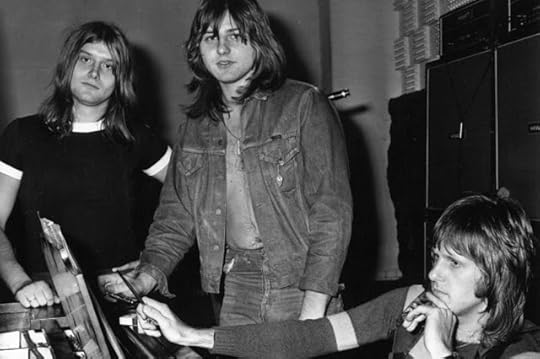 Atomic Rooster, alongside bands like The Nice, bridged the gap between the psychedelic garage sound so prevalent in America and progressive rock. He stated that while working with Atomic Rooster he realized he liked working with small groups, preferably a trio where he got to open up his playing and try to do the things he admired in the work of his idol Buddy Rich. After the release of the Atomic Rooster debut, Palmer met Greg Lake of King Crimson, which had “split up” during their first American tour, and Keith Emerson of The Nice, who had split with his group amid a chaotic year that saw the collapse of its label, Immediate Records. In a sense, Palmer was the vertex of the triangle formed by the three personalities, a Beatles fan and a pop/rock enthusiast like Lake, and a jazz enthusiast like Emerson.
Atomic Rooster, alongside bands like The Nice, bridged the gap between the psychedelic garage sound so prevalent in America and progressive rock. He stated that while working with Atomic Rooster he realized he liked working with small groups, preferably a trio where he got to open up his playing and try to do the things he admired in the work of his idol Buddy Rich. After the release of the Atomic Rooster debut, Palmer met Greg Lake of King Crimson, which had “split up” during their first American tour, and Keith Emerson of The Nice, who had split with his group amid a chaotic year that saw the collapse of its label, Immediate Records. In a sense, Palmer was the vertex of the triangle formed by the three personalities, a Beatles fan and a pop/rock enthusiast like Lake, and a jazz enthusiast like Emerson.Within a year of Emerson, Lake & Palmer's debut in the summer of 1970, Palmer became one of the most idolized rock drummers in the world, the group's debut album showcasing a level of speed, dexterity, and taste that was wholly removed from the kind of playing prevalent at the time, even that of Moon or Bonham, and more like Ginger Baker (of course, the jazz influence) or Palmer’s contemporary Bill Bruford. When push comes to shove, and while never getting the accolades, Palmer is what is best in the jazz of Bruford, the syncopation of Bonham and the wild-man tenacity of Moony. Palmer is a drummer’s drummer.
January 6, 2021
Brain Salad Surgery (AM8)Artist: Emerson, Lake and Palmer...
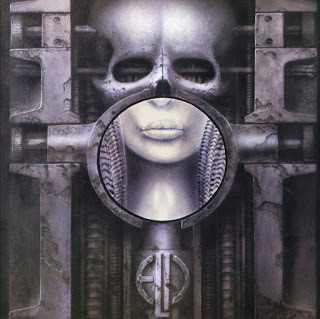 Brain Salad Surgery
(AM8)
Brain Salad Surgery
(AM8)Artist: Emerson, Lake and Palmer
Producer: Greg Lake
Length: 45:04
Released: November 19, 1973
Tracks: 1) Jerusalem (2:44) 2) Toccata (7:20) 3) Still You Turn Me On (2:52); 4) Bennie the Bouncer (2:15) 5) Karn Evil 9, 1st Impression (8:39) 6) Karn Evil 9, 1st Impression, Part II (4:43) 7) Karn Evil 9, 2nd Impre4ssion (7:07); 8) Karn Evil 9, 3rd Impression (9:07)
Personnel: Keyboards (Hammond Organ C3, Steinway Piano, Moog Synthesizer IIIC, Mini Moog, Poly Moog, Moog Taurus) –Keith Emerson; Vocals, Bass, Acoustic, Electric and 12 String Guitars – Greg Lake; Drums, Percussion, Tympani, Tubular Bells – Carl Palmer
When Emerson, Lake & Palmer released their fourth studio album, Brain Salad Surgery, on November 19, 1973, the band's extravagantly audacious blend of outer-limits progressive rock, fantastical re-imaginings of classics and lush, pastoral pop balladry reached a creative and commercial peak. ELP's previous efforts accessed sizable but disparate audiences – art-rockers flocked to Tarkus and Trilogy while curious classical adventure seekers embraced Pictures At An Exhibition – but with Brain Salad Surgery, the trio put the mainstream directly in their crosshairs without sacrificing their prodigious instrumental chops."We were still ascending when we made Brain Salad Surgery," Keith Emerson says. "We were enjoying a sensational amount of success, and I suppose we felt as if we could do anything – and we certainly tried. Musically, lyrically and visually, we really went for it."The album would be the inaugural release by the band's newly formed Manticore label and would differ from the extensively overdubbed Trilogy in that the group plotted out the music as a largely live creation. At the start of 1973, Emerson, Greg Lake and Carl Palmer purchased an abandoned cinema in Fulham, London, and converted it into a rehearsal and production facility, using an upstairs foyer to assemble and run through new compositions.“That was the general idea, to play the album live," Emerson recalls. "I pretty much had the whole concept in mind. We had taken a bit of a break to be with our families, so that gave me a fair enough time to put down enough hand-written ideas for the "Karn Evil 9." I then approached Greg and Carl with a sheaf of manuscript papers, and we set about rehearsing, going over the material and being sort of repetitive about it."
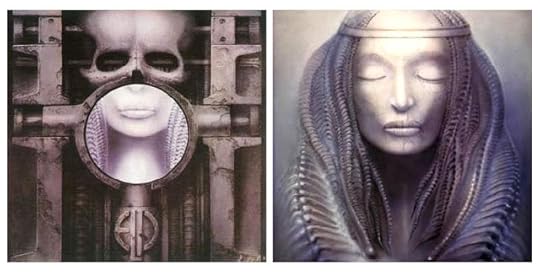
Once the epic "Karn Evil 9" was worked out – the 30-minute sci-fi tale of man vs machine would spill over from side one and encompass the whole of side two – ELP loosened up with the deliciously lighthearted honky-tonk saloon spoof "Benny The Bouncer." "We liked to get the serious stuff out of the way and then do something fun," Emerson says. "We had done "Are You Ready Eddy?" and "The Sheriff" before. It was always a nice little breather to soften the mood, both in the studio and on record."To complete the lyrics to both "Karn Evil 9" and "Benny The Bouncer," Lake recruited his old pal and former King Crimson bandmate Peter Sinfield. "Greg had always been a prolific songwriter and lyricist," Emerson notes, "but at this particular time, he needed the influence of somebody he had confidence in. Pete brought a lot of fantastic ideas and lines to the songs."Recording took place between June and September of 1973 at London's Advision and Olympic Studios, with Lake, as he had done on the group's previous albums, serving as producer. "It was a pretty straightforward time in the studio," Emerson says, "even with some of the new pieces of equipment we were using, like the Moog Apollo. Because we were so rehearsed, there wasn't a lot of mucking about. We didn't have Pro Tools and all the things that exist now. If a person made a mistake, you didn't say, 'Oh, we'll fix that later.' We really had to get it right as we played together."Trilogy and Brain Salad Surgery stand up as two of the great albums in one of rock's most incredibly prolific years. Released simultaneously were Fragile and Close to the Edge, Ziggy Stardust and Aladdin Sane, Thick as a Brick, Genesis' Fox Trot and Selling England by the Pound, PFM's Per Un Amico, Three Friends and Octopus, Roxy Music, Seventh Sojourn, ELO II and On the Third Day, Can't Buy a Thrill, Obscured By Clouds, Machine Head, Neil Young's Harvest, Transformer...
January 5, 2021
ELP - Trilogy - AM9.1
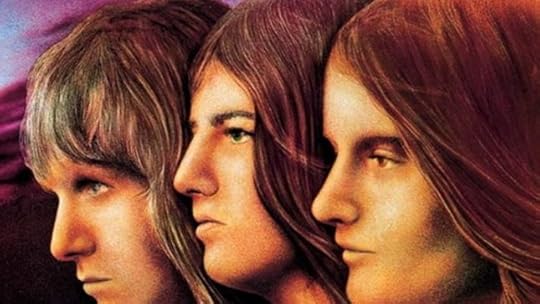 Trilogy
(AM9.1)
Trilogy
(AM9.1)Artist: Emerson, Lake and Palmer
Producer: Greg Lake
Length: 42:23
Released: July 6, 1972
Tracks: 1) The Endless Enigma I (6:41) 2) Fugue (1:56) 3) The Endless Enigma II (2:03); 4) From the Beginning (4:16) 5) The Sheriff (3:22) 6) Hoedown (3:47) 7) Trilogy (8:54); 8) Living Sin (3:13); 9) Abaddon's Bolero (8:08)
Personnel: Keyboards (Hammond Organ C3, Steinway Piano, Moog Synthesizer IIIC, Mini Moog) – Keith Emerson; Vocals, Bass – Greg Lake; Drums, Percussion – Carl Palmer
Emerson, Lake and Palmer's fourth LP (third studio effort), Trilogy, opens with the sound of a heartbeat to frame the subject of the meaning of life, or life in a cultural construct. The eerie sounds Keith Emerson creates on the Moog, combined with sudden piano runs and fading bongos, establish a sense of mystery that quickly manifests itself into chaos, like the restlessness of a tortured soul. After the band slows the tempo to provide a proper introduction, the vocals begin, with Lake at his best. At first, we don't know to whom the narrator is speaking, until, late in the sequence he admits that the sins ascribed to others are his own, the personification of humanity looking at itself in the mirror. The instrumentation is phenomenal with synth, piano, even a zourka, Palmer's incessant drum fills and Lake's distinctive bass and clear tenor. The song is divided in half by "Fugue" a superb piano interlude with Lake's bass syncopated nicely in the background and Palmer's simple triangle adding a touch of counterpoint. The music changes mood and melody significantly through the pieces: some quiet, some heavy and full of passion. Emerson's synthesizer finally emulates bells and trumpets as Lake belts out the climax to the lengthy track. Lake's vocals are thrilling and hotly emotive, particularly in lines like "They make me sick and tired" and "Please, please, please open their eyes" against Emerson's intrusive Hammond. And then the compelling final verse:
Each part was playedThough the play was not shownEveryone cameThough they all sat aloneThe dawn opened the playBreaking the dayCausing a silent hoorayThe dawn will break another dayNow that it's doneI've begun to see the reason why I'm here.

"The Endless Enigma" is frankly fucking fabulous, one of the great works of progressive rock, followed by an FM standard, one of three by Lake in the canon, "From the Beginning." After the lyrical ballad concludes, Emerson's iconic synth solo ends the track. "The Sheriff" is a playful ditty and the chance for Emerson to show his prowess and diversity, as does "Hoedown," a send-off to Aaron Copland and finally "Abaddon's Bolero," with two tracks that precede the band's musical take on the Armageddon.
The lesser of those is "Living Sin," a heady, dark track, with Lake growling the lyrics in a theatrical seedy undertone: "If you never saw it coming, Hooked you up with Coca-Cola coming, Nice and slippery." While I enjoy the effort, particularly those lyrics, that Golem-esque voice is one of the reason's that Trilogy is only an AM9; while the track redeems itself in other ways.
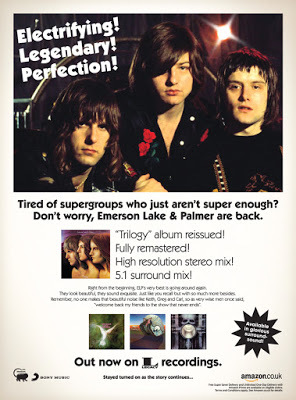 On "Trilogy," the LP's side two opus, Emerson's piano again sounds the business: crisp, clear Steinway, with the introductory section sounding like progressive Gershwin. Later Emerson brings in Hammond and synthesizers and really rocks it up during a long instrumental section. The track tells the story of a breakup and the profound emotional trauma it entails. The patter-like lyrics, though, are what bring the track to life.
On "Trilogy," the LP's side two opus, Emerson's piano again sounds the business: crisp, clear Steinway, with the introductory section sounding like progressive Gershwin. Later Emerson brings in Hammond and synthesizers and really rocks it up during a long instrumental section. The track tells the story of a breakup and the profound emotional trauma it entails. The patter-like lyrics, though, are what bring the track to life.I've tried to mendThe love that endedLong ago although we still pretendOur love is surely coming to an endDon't waste the time you've got to love againWe tried to lieBut you and IKnow better than to let each other lieThe thought of lying to you makes me cryCounting up the time that's passed us byI've sent this letter hoping it will reach your handAnd if it does I hope that you will understandThat I must leave in a whileAnd though I smileYou know the smile is only there to hideWhat I'm really feeling deep insideJust a face where I can hang my prideGoodbye...Goodbye...We'll talk of places that we wentAnd times that we have spentTogether penniless and freeYou'll see the day another wayAnd wake up with the sunshinePourin’ right down where you layYou'll love again, I don't know whenBut if you do I know that you'll be happy in the end
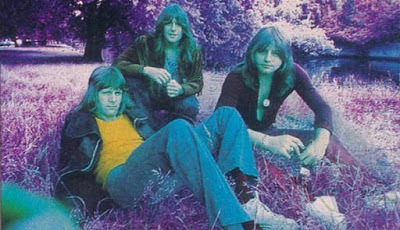 While the rhyme scheme is quite clever and pronounced, it's the content of the lyrics that capture the story's essence, particularly in the use of three separate tenses as the lyrics progress. The lyrics in the first verse are past-tense; reflective and looking back at what the relationship once was. The second verse is written in the present-tense describing the day when the "ex" no longer feels pain over the breakup. After the extended instrumental section, the third verse, in the future-tense, reassures her that they will find love and happiness once again, in time.
While the rhyme scheme is quite clever and pronounced, it's the content of the lyrics that capture the story's essence, particularly in the use of three separate tenses as the lyrics progress. The lyrics in the first verse are past-tense; reflective and looking back at what the relationship once was. The second verse is written in the present-tense describing the day when the "ex" no longer feels pain over the breakup. After the extended instrumental section, the third verse, in the future-tense, reassures her that they will find love and happiness once again, in time.Rather than being left with some kind of false Disney ending, the listener hopes instead that the breakup works out for the best. There isn't an overwhelming urge to hear the narrator and the ex getting back together. The listener, first hand, has also been exposed to the pain, the confusion, the anxiety, and the loneliness of the breakup, but then as well, the clarity, simplicity and optimism of what lies ahead. The ending is a rational reflection that doesn't call for back-pedaling to the way things were.
Two solid epics, two glorious instrumentals, a phenomenal love song, some kitchy western hoopededoo and a disposable, if acceptable three minute toss-out, make for a solid AM9, vying for one's attention as a 10.
January 3, 2021
Emerson, Lake and Palmer - From the Beginning
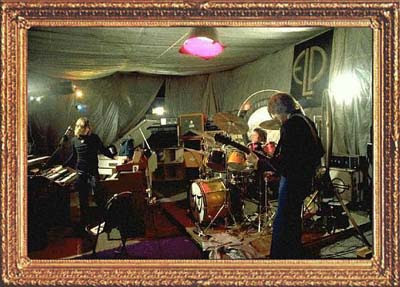 Keith Emerson began his formal music education at eight years old. Quickly tiring of "playing like Bach," Emerson discovered American free form jazz, particularly that of progressive organist Jack McDuff. After playing in several bands throughout college, where he purchased a Hammond L100 electric piano, Emerson heard that P.P. Arnold, a successful solo R&B singer was looking for a backup band. Emerson formed The Nice, with this intent, though six months later the band began performing on their own. During late 1967, the band opened for Pink Floyd and Jimi Hendrix, often at The Marquee Club, whose dossier included David Bowie and the Lower Third, The Yardbirds, Manfred Mann, The Move and The Small Faces. In January 1968, The Nice traveled to the U.S. returning to Britain just in time for the release of their debut, The Thoughts of Emerlist Davjack (a contraction of the band members' names). They later recorded "America," a work that combined Leonard Bernstein's famous piece from West Side Story, Dvorak's New World Symphony and protest lyrics, making for a complex political statement (as well as a controversial one since Bernstein didn't initially approve). During a King Crimson/Nice show in 1969, Emerson met Crimson's young bass player, Greg Lake, backstage, and after a brief chat, they tentatively decided to form a band.
Keith Emerson began his formal music education at eight years old. Quickly tiring of "playing like Bach," Emerson discovered American free form jazz, particularly that of progressive organist Jack McDuff. After playing in several bands throughout college, where he purchased a Hammond L100 electric piano, Emerson heard that P.P. Arnold, a successful solo R&B singer was looking for a backup band. Emerson formed The Nice, with this intent, though six months later the band began performing on their own. During late 1967, the band opened for Pink Floyd and Jimi Hendrix, often at The Marquee Club, whose dossier included David Bowie and the Lower Third, The Yardbirds, Manfred Mann, The Move and The Small Faces. In January 1968, The Nice traveled to the U.S. returning to Britain just in time for the release of their debut, The Thoughts of Emerlist Davjack (a contraction of the band members' names). They later recorded "America," a work that combined Leonard Bernstein's famous piece from West Side Story, Dvorak's New World Symphony and protest lyrics, making for a complex political statement (as well as a controversial one since Bernstein didn't initially approve). During a King Crimson/Nice show in 1969, Emerson met Crimson's young bass player, Greg Lake, backstage, and after a brief chat, they tentatively decided to form a band.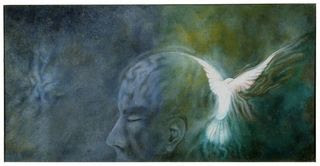 Greg Lake began his musical tenure when given a guitar by his mother. As a school boy he wrote the song that would later become one of ELP's greatest hits, "Lucky Man." During the late '60s, Lake played in several bands, and one of these, The Shy Limbs, nearly got him killed. The band slept in a van and ate when they could. Lake developed complications from pneumonia and nearly died before his mother intervened and checked him into the hospital.
Greg Lake began his musical tenure when given a guitar by his mother. As a school boy he wrote the song that would later become one of ELP's greatest hits, "Lucky Man." During the late '60s, Lake played in several bands, and one of these, The Shy Limbs, nearly got him killed. The band slept in a van and ate when they could. Lake developed complications from pneumonia and nearly died before his mother intervened and checked him into the hospital.While bassist for The Gods, Lake caught the attention of Robert Fripp, who was searching for a bassist for King Crimson. Lake sang and played bass on the band's first album, In The Court Of The Crimson King, but Fripp's "tyranny" alienated Lake, who remained with KC just long enough to record Crimson's 2nd album, In The Wake Of Poseidon (as lead singer but not as bassist).
While Emerson and Lake searched for a percussionist, they met Mitch Mitchell, Jimi Hendrix's drummer, who didn't wish to join but endeavored to get Hendrix into the new band. After inviting Carl Palmer, a young drummer from Atomic Rooster and The Crazy World of Arthur Brown, the British Press fantasized about a new band with two virtuosi like Hendrix and Emerson, and speculated the band would be called Hendrix, Emerson, Lake and Palmer or HELP, but Hendrix died in September 1970 before the idea came to fruition.
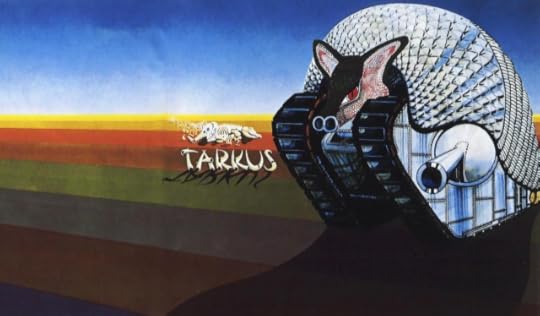 By October, Emerson, Lake and Palmer released their eponymous debut LP. The newly formed band sounded like a veteran supergroup. Emerson, Lake and Palmer (AM7) represents what happens when the right musicians find each other at the right time. All three fresh from other notable bands, it was a meeting of the gods. The fact that albums like this are given short shrift by rock critics says far more about the dark state of rock criticism than it does about the quality of the music therein. Every second on Emerson, Lake And Palmer's debut LP (with the exception of Palmer's accomplished but somewhat needless drum solo on "Tank") is a triumph, as the group moves effortlessly between the multiverse of rock, jazz and classical before heading into the newly-charted realms of electronica with the Moog. Their sense of ensemble on tracks like "The Barbarian" and "Take A Pebble" is breathtaking. Hearing "Knife Edge" for the first time on KMET in 1974, over a crackly FM transmitter, sent a chill down my spine that has never quite gone away.
By October, Emerson, Lake and Palmer released their eponymous debut LP. The newly formed band sounded like a veteran supergroup. Emerson, Lake and Palmer (AM7) represents what happens when the right musicians find each other at the right time. All three fresh from other notable bands, it was a meeting of the gods. The fact that albums like this are given short shrift by rock critics says far more about the dark state of rock criticism than it does about the quality of the music therein. Every second on Emerson, Lake And Palmer's debut LP (with the exception of Palmer's accomplished but somewhat needless drum solo on "Tank") is a triumph, as the group moves effortlessly between the multiverse of rock, jazz and classical before heading into the newly-charted realms of electronica with the Moog. Their sense of ensemble on tracks like "The Barbarian" and "Take A Pebble" is breathtaking. Hearing "Knife Edge" for the first time on KMET in 1974, over a crackly FM transmitter, sent a chill down my spine that has never quite gone away. 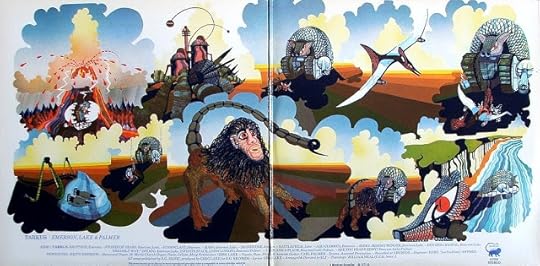 Tarkus (AM7) saw Emerson, Lake And Palmer trying their darnedest to outplay their contemporaries - a goal which they succeed effortlessly in achieving - although as a result the album lacks a sense of restraint. Its centerpiece is the title suite that took up all of side one, an intense, varied 20-minute prog epic that hits the listener like a ton of bricks; its first impression will either leave one fascinated by its originality and virtuosity, or running from the room screaming overkill. Were Tarkus written by a contemporary western avant-garde composer (think John Cale or today, Nico Muhly), it would have been recognized as the complex atonal a-rhythmic masterpiece that it is. For most rock listeners, however, the album simply asks too much. It is a complex work full of invention and shifting horizons, far more complex and coherent than even the most celebrated rock albums previously called "complex." A schizophrenic hootenanny, "Tarkus," the LP's shining focus, is indeed a glorious slab of prime prog. Emerson's Hammond B3 and Moog are out of this world, Lake's vocals and under-rated bass work are exceptional and Palmer provides what is the strongest long-form track of his career.
Tarkus (AM7) saw Emerson, Lake And Palmer trying their darnedest to outplay their contemporaries - a goal which they succeed effortlessly in achieving - although as a result the album lacks a sense of restraint. Its centerpiece is the title suite that took up all of side one, an intense, varied 20-minute prog epic that hits the listener like a ton of bricks; its first impression will either leave one fascinated by its originality and virtuosity, or running from the room screaming overkill. Were Tarkus written by a contemporary western avant-garde composer (think John Cale or today, Nico Muhly), it would have been recognized as the complex atonal a-rhythmic masterpiece that it is. For most rock listeners, however, the album simply asks too much. It is a complex work full of invention and shifting horizons, far more complex and coherent than even the most celebrated rock albums previously called "complex." A schizophrenic hootenanny, "Tarkus," the LP's shining focus, is indeed a glorious slab of prime prog. Emerson's Hammond B3 and Moog are out of this world, Lake's vocals and under-rated bass work are exceptional and Palmer provides what is the strongest long-form track of his career. 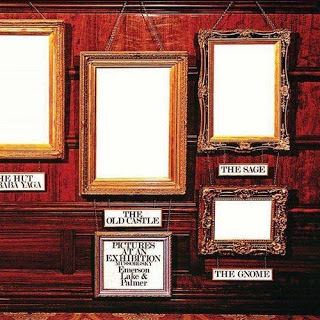 As for the concept, well, there's this armadillo-tank thing and it kills a bunch of creature things until one of them kills it, so, like a lot of fantasy prog, Tarkus is essentially a mess of pretentious hoo-hah over nothing. And I for one happen to love it.
As for the concept, well, there's this armadillo-tank thing and it kills a bunch of creature things until one of them kills it, so, like a lot of fantasy prog, Tarkus is essentially a mess of pretentious hoo-hah over nothing. And I for one happen to love it.My first experience with classical music was through Looney Tunes, most specifically Elmer Fudd's "Barber of Seville" or the "Kill da wabbit" scene in "What's Opera Doc?" In lieu of that, maybe it was the odd take on classical that was Ray Conniff's Concert in Rhythm on which my mother sang back up vocals. While this kind of exposure seems trivial, it helped to create a life long quest for more music. Naturally as a young teen the Peter and the Wolf sensibility of progressive rock made an impression, as did rock music in general as it often borrowed from the classical canon. I remember seeing Bowie at the Santa Monica Civic in 1972 with my older brother. Before Bowie hit the stage, the decibels were cranked on towers of amps playing Beethoven's 9th. And in 1968, I was struck by Blood, Sweat and Tears take on Satie's Trois Gymnopedies, still one of my favorite classical arrangements.
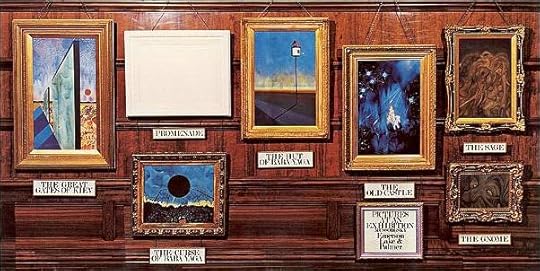
My further immersion into classical music would have me bring home ELP's Pictures at an Exhibition. I'd heard ELP prior to this, but this, to my novice ears, was the real deal.Greg Lake adds some light philosophical/trippy-dippy lyrics to the Modest Mussourgsky masterpiece, and like every piece of excess ELP did early in their career, it works. Keith Emerson traipses through most every tone he can get from his early synth arsenal (jarring or otherwise) , giving him the U.K. moniker "the Hendrix of Keyboards" (oh brother, but you get the point). Rumor has it Jimi actually wanted to join the band after hearing this album. Just think! Hendrix, Emerson, Lake, and Palmer (or HELP, for short). Pictures has more raw urgency than anything in their catalog, and while Jimi may have had an ear for its brilliance, most of us, myself included, find this the least accessible ELP LP.



